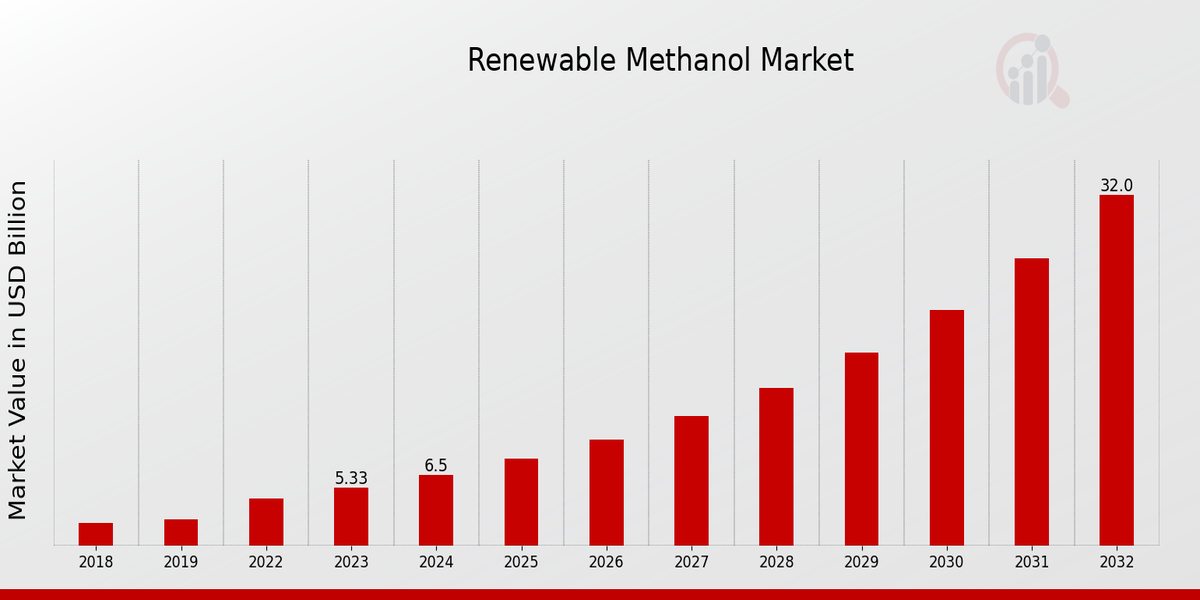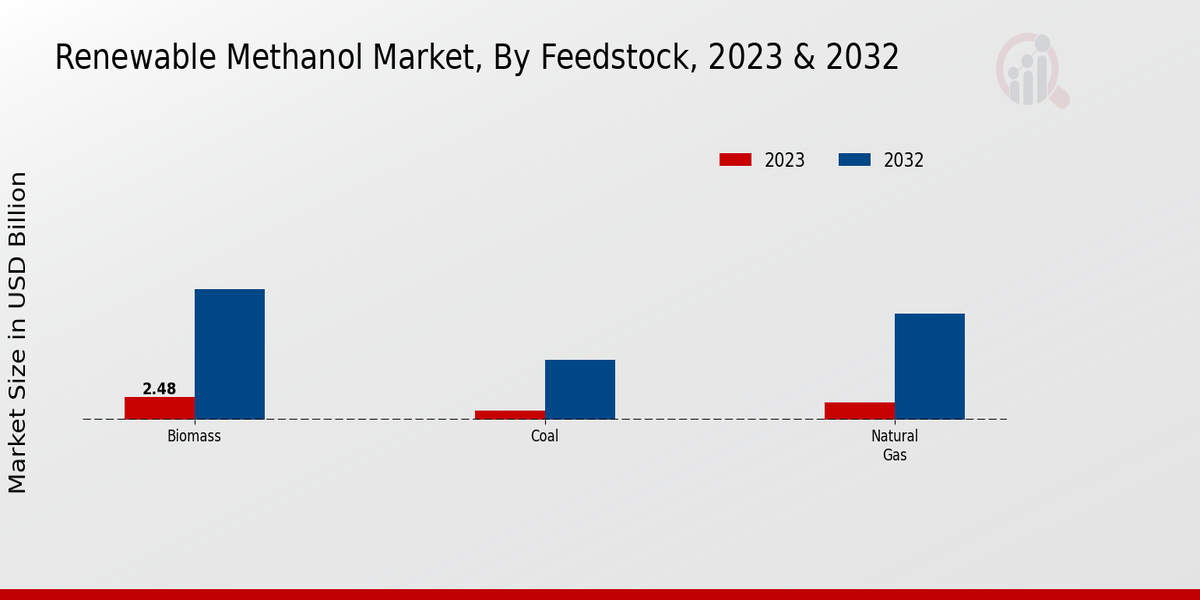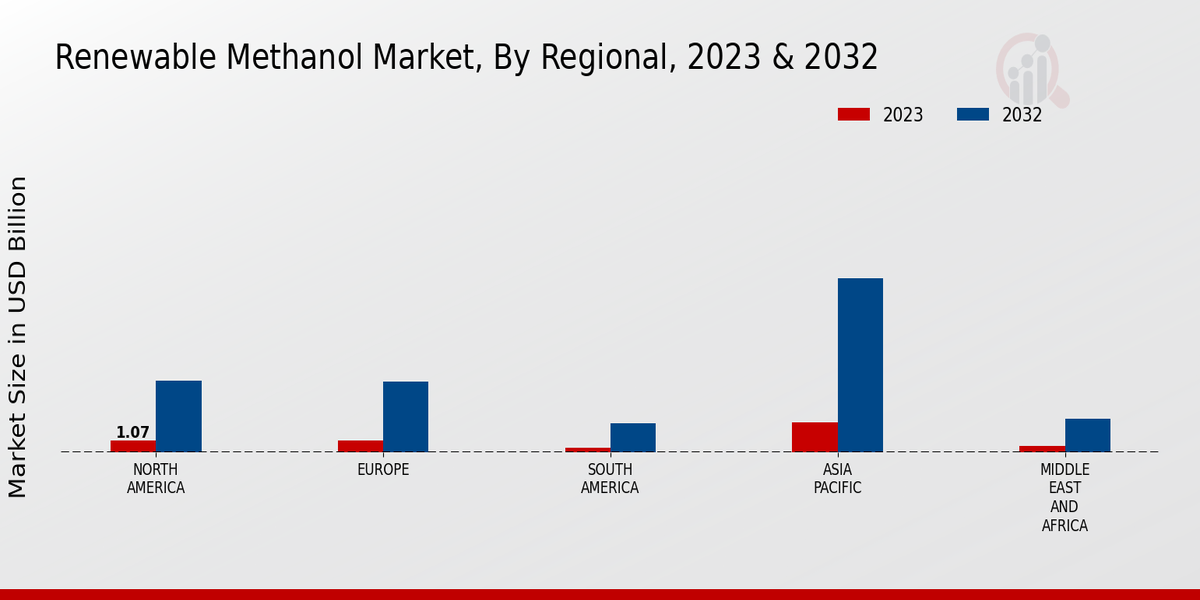Global Renewable Methanol Market Overview
As per MRFR analysis, the Renewable Methanol Market Size was estimated at 4.36 (USD Billion) in 2022. The Renewable Methanol Market Industry is expected to grow from 5.33(USD Billion) in 2023 to 32.0 (USD Billion) by 2032. The Renewable Methanol Market CAGR (growth rate) is expected to be around 22.05% during the forecast period (2024 - 2032).
Key Renewable Methanol Market Trends Highlighted
The Renewable Methanol Market is experiencing a surge in demand driven by commitments to reduce carbon emissions and transition towards sustainable energy sources. Key market drivers include government mandates, incentives for renewable fuel production, and increasing consumer preference for environmentally friendly products.Opportunities lie in the expansion of production capacities, particularly in regions with abundant renewable energy resources such as wind and solar. Technological advancements are also creating opportunities for cost-effective and efficient renewable methanol production methods. The market is expected to grow significantly in the coming years as industries seek to decarbonize their operations and meet regulatory requirements.Recent trends indicate a shift towards integrated and decentralized production models, as well as the emergence of blended fuels that incorporate renewable methanol with traditional fossil fuels. Partnerships between various stakeholders, including fuel producers, vehicle manufacturers, and energy infrastructure providers, are also shaping the market landscape. These collaborations aim to foster innovation, accelerate the adoption of renewable methanol, and establish a sustainable value chain.

Source: Primary Research, Secondary Research, MRFR Database and Analyst Review
Renewable Methanol Market Drivers
Increasing Demand for Sustainable Fuels
The growing demand for sustainable and environmentally friendly energy sources is a major driver of the Renewable Methanol Market Industry. Methanol, a clean-burning and biodegradable fuel, is increasingly being used as an alternative to fossil fuels in various sectors such as transportation, power generation, and heating. Governments worldwide are implementing policies and regulations to promote the adoption of renewable energy sources, including methanol, which is expected to drive market growth in the coming years.
Technological Advancements in Methanol Production
Advancements in methanol production technologies are another key driver of the Renewable Methanol Market Industry. The development of efficient and cost-effective methods for producing methanol from renewable feedstocks, such as biomass and natural gas, has made renewable methanol a more viable and attractive option. Ongoing research and development in this area are expected to further reduce production costs and improve the sustainability of methanol production, which will contribute to the growth of the market.
Expanding Applications of Methanol
The expanding applications of methanol in various industries are also driving the growth of the Renewable Methanol Market Industry. Methanol is used as a fuel, a chemical feedstock, and a solvent in a wide range of applications. The growing demand for methanol in the chemical industry, particularly in the production of plastics, adhesives, and pharmaceuticals, is a major factor driving market growth. Additionally, the use of methanol as a fuel in transportation, especially in shipping and heavy-duty vehicles, is expected to increase in the coming years, further contributing to market expansion.
Renewable Methanol Market Segment Insights
Renewable Methanol Market Feedstock Insights
The feedstock segment plays a vital role in determining the cost and sustainability of renewable methanol production. Biomass, coal, and natural gas are the primary feedstocks used in the industry. Biomass is a renewable and sustainable feedstock that is derived from plant matter, such as wood, agricultural residues, and algae. It is a carbon-neutral feedstock, meaning that the carbon emitted during its production is offset by the carbon absorbed by the plants during their growth. Biomass is expected to account for a significant share of the renewable methanol market in the coming years due to its low cost and environmental benefits, with values expected to reach 2.479 USD Billion in 2023 and 14.118 USD Billion in 2032.Coal is a fossil fuel that is used as a feedstock for methanol production in some regions, particularly in China. Coal is a relatively inexpensive feedstock, but it has a high carbon footprint. The use of coal for methanol production is expected to decline in the future due to environmental concerns, with values estimated at 0.992 USD Billion in 2023 and 6.454 USD Billion in 2032. Natural gas is a fossil fuel that is used as a feedstock for methanol production in many regions, including North America and Europe. Natural gas is a relatively clean-burning fuel, but it still emits greenhouse gases. The use of natural gas for methanol production is expected to continue in the future, but it is likely to be supplemented by renewable feedstocks, with values projected to be 1.859 USD Billion in 2023 and 11.429 USD Billion in 2032.The choice of feedstock for renewable methanol production depends on a number of factors, including cost, availability, and environmental impact. Biomass is the most sustainable feedstock, but it can be more expensive than coal or natural gas. Coal is the least expensive feedstock, but it has the highest carbon footprint. Natural gas is a relatively clean-burning fuel, but it still emits greenhouse gases. The Renewable Methanol Market is expected to grow significantly in the coming years, driven by increasing demand for sustainable fuels and chemicals.The feedstock segment is expected to play a key role in this growth, as the choice of feedstock can have a significant impact on the cost, sustainability, and environmental impact of renewable methanol production.

Source: Primary Research, Secondary Research, MRFR Database and Analyst Review
Renewable Methanol Market Technology Insights
The technology segment of the Renewable Methanol Market plays a crucial role in determining the production methods employed to convert renewable feedstocks into methanolmong the key technologies utilized in this market is Steam Reforming. This process involves the reaction of renewable feedstocks, such as biomass or natural gas, with steam to produce syngas, which is then converted into methanol. Steam reforming is widely adopted due to its established technology and cost-effectiveness. Gasification: In this process, renewable feedstocks are subjected to high temperatures and limited oxygen to generate a mixture of gases, including hydrogen and carbon monoxide.These gases are subsequently synthesized to produce methanol. Gasification offers advantages in terms of feedstock flexibility and the potential to utilize a broader range of renewable sources. Methanol Synthesis: This critical step in the production process involves the conversion of syngas into methanol using a catalyst. Methanol synthesis technology has undergone significant advancements, leading to improved efficiency and reduced emissions. The Renewable Methanol Market research report provides comprehensive data on the market segmentation, industry trends, and regional growth dynamics.The report offers valuable insights into the market size, growth rate, competitive landscape, and key market drivers. Moreover, it includes a detailed analysis of the technology segment, highlighting the market share, growth potential, and technological advancements for each technology type.
Renewable Methanol Market Application Insights
The application segment of the Renewable Methanol Market holds significant importance, influencing the overall market growth. Among the key applications, Transportation Fuels, Chemical Production, and Power Generation stand out as major contributors. Transportation Fuels account for a notable share of the market, driven by rising demand for sustainable and low-carbon alternatives in the transportation sector. Chemical Production holds a significant position, as methanol serves as a crucial feedstock for producing various chemicals, including formaldehyde, acetic acid and MTBE.Power Generation is another key application, leveraging methanol's potential as a clean-burning fuel in power plants, contributing to the global transition towards greener energy sources. This growth is attributed to increasing environmental concerns, favorable government policies, and technological advancements in renewable methanol production.
Renewable Methanol Market Capacity Insights
The Renewable Methanol Market is segmented by capacity into small-scale (less than 100,000 tons per year), medium-scale (100,000 - 500,000 tons per year), and large-scale (over 500,000 tons per year). The large-scale segment is expected to dominate the market in the coming years due to the increasing demand for renewable methanol from large-scale industries such as the chemical and transportation sectors. The medium-scale segment is also expected to witness significant growth due to the increasing number of small and medium-sized enterprises adopting renewable methanol as a sustainable fuel source.The small-scale segment is expected to grow at a steady pace due to the increasing adoption of renewable methanol in residential and commercial applications.
Renewable Methanol Market End-Use Insights
The Renewable Methanol Market segmentation by End-Use includes Industrial, Residential, Commercial and Transportation. The Industrial segment is expected to dominate the market in 2023, accounting for around 40% of the Renewable Methanol Market revenue. This is due to the growing demand for renewable methanol in the chemical industry, where it is used as a feedstock for the production of various chemicals such as formaldehyde, acetic acid, and olefins. The Residential segment is expected to grow at a steady pace, driven by the increasing adoption of renewable methanol for heating and cooking purposes.The Commercial segment is also expected to witness significant growth, as more businesses are adopting renewable methanol as a fuel for their operations. The Transportation segment is expected to be the fastest-growing segment, with a CAGR of over 25%. This is due to the growing demand for renewable methanol as a fuel for ships, trains, and other heavy-duty vehicles.
Renewable Methanol Market Regional Insights
The Renewable Methanol Market is segmented into North America, Europe, APAC, South America and MEA. Among these regions, APAC is expected to dominate the market in the coming years, owing to the increasing demand for renewable energy sources in the region. The region is also witnessing a growing number of government initiatives and policies aimed at promoting the adoption of renewable energy technologies. North America and Europe are also expected to witness significant growth in the renewable methanol market due to the presence of well-established biofuel industries and supportive government policies.The MEA region is expected to emerge as a potential market for renewable methanol, driven by the growing demand for clean energy sources in the region. The South American market for renewable methanol is expected to witness moderate growth over the forecast period due to the increasing awareness about the environmental benefits of renewable energy sources.

Source: Primary Research, Secondary Research, MRFR Database and Analyst Review
Renewable Methanol Market Key Players And Competitive Insights
Major players in Renewable Methanol Market the Renewable Methanol Market industry is highly competitive, with a number of leading Renewable Methanol Market players vying for market share. Some of the key players in this market include Methanol Holdings, Methanex, Celanese and INEOS. These companies have a strong presence in the Renewable Methanol Market, with a wide range of products and services to offer customers. They are also investing heavily in Renewable Methanol Market development, in order to stay ahead of the competition. The Renewable Methanol Market Competitive Landscape is expected to remain competitive in the coming years as new entrants enter the market and existing players expand their operations.Renewable Methanol Market competitor Methanol Holdings is a leading producer of methanol with a global presence. The company has a strong focus on sustainability and is committed to reducing its environmental impact. Methanol Holdings is investing heavily in Renewable Methanol Market development, and is working to develop new technologies that will make renewable methanol more cost-effective.Another major player in the Renewable Methanol Market is Methanex. The company is a global leader in the production and marketing of methanol. Methanex has a strong focus on innovation and is constantly developing new technologies to improve its products and processes. The company is also committed to sustainability and is working to reduce its environmental impact.
Key Companies in the Renewable Methanol Market Include
- Sunfire
- Haldor Topsoe
- Johnson Matthey
- Lanzatech
- Carbon Engineering
- Mitsubishi Chemical Holdings
- Saudi Arabian Basic Industries Corporation (SABIC)
- Clariant
- Chemrec
- Neste
- Red Rock Biofuels
- Methanol Catalysts Company
- OCI
- Enerkem
- Covestro
Renewable Methanol Market Industry Developments
The Renewable Methanol Market is projected to grow from USD 5.33 billion in 2023 to USD 32.0 billion by 2032, at a CAGR of 22.05% over the forecast period. The market is driven by increasing demand for renewable fuels and chemicals, government regulations promoting the use of sustainable energy sources, and technological advancements in methanol production. Asia-Pacific is expected to be the largest market for renewable methanol, followed by Europe and North America.Recent news developments in the renewable methanol market include: In January 2023, Carbon Recycling International (CRI) announced the start-up of its commercial-scale renewable methanol plant in Norway, which has a production capacity of 100,000 tonnes per year. In February 2023, Haldor Topsoe signed an agreement with Consolidated Contractors Company (CCC) to build a green methanol plant in Oman with a production capacity of 1 million tonnes per year. In March 2023, the European Union (EU) announced plans to invest €2 billion in renewable methanol production projects as part of its REPowerEU initiative.These developments indicate the growing interest and momentum in the renewable methanol market, driven by the need for sustainable energy solutions and the increasing adoption of renewable fuels and chemicals.
-
Renewable Methanol Market Segmentation Insights
-
Renewable Methanol Market Feedstock Outlook
-
Renewable Methanol Market Technology Outlook
- Steam Reforming
- Gasification
- Methanol Synthesis
-
Renewable Methanol Market Application Outlook
- Transportation Fuels
- Chemical Production
- Power Generation
-
Renewable Methanol Market Capacity Outlook
- Small-scale (less than 100,000 tons per year)
- Medium-scale (100,000 - 500,000 tons per year)
- Large-scale (over 500,000 tons per year)
-
Renewable Methanol Market End-Use Outlook
- Industrial
- Residential
- Commercial
- Transportation
-
Renewable Methanol Market Regional Outlook
-
North America
-
Europe
-
South America
-
Asia Pacific
-
Middle East and Africa
| Report Attribute/Metric |
Details |
| Market Size 2022 |
4.36(USD Billion) |
| Market Size 2023 |
5.33(USD Billion) |
| Market Size 2032 |
32.0(USD Billion) |
| Compound Annual Growth Rate (CAGR) |
22.05% (2024 - 2032) |
| Report Coverage |
Revenue Forecast, Competitive Landscape, Growth Factors, and Trends |
| Base Year |
2023 |
| Market Forecast Period |
2024 - 2032 |
| Historical Data |
2019 - 2023 |
| Market Forecast Units |
USD Billion |
| Key Companies Profiled |
Sunfire, Haldor Topsoe, Johnson Matthey, Lanzatech, Carbon Engineering, Mitsubishi Chemical Holdings, Saudi Arabian Basic Industries Corporation (SABIC), Clariant, Chemrec, Neste, Red Rock Biofuels, Methanol Catalysts Company, OCI, Enerkem, Covestro |
| Segments Covered |
Feedstock, Technology, Application, Capacity, End-Use, Regional |
| Key Market Opportunities |
1. EV battery storage 2. Green hydrogen production 3. Sustainable fuel source 4. Petrochemical feedstock 5. Transportation sector |
| Key Market Dynamics |
1 Growing demand for sustainable fuels2 Technological advancements in renewable methanol production3 Government incentives and regulations4 Increasing investments in renewable methanol projects5 Fluctuating feedstock prices |
| Countries Covered |
North America, Europe, APAC, South America, MEA |
Frequently Asked Questions (FAQ) :
The Renewable Methanol Market is expected to reach a valuation of USD 32.0 billion by 2032, exhibiting a CAGR of 22.05% during the forecast period (2024-2032).
Asia-Pacific is anticipated to dominate the Renewable Methanol Market throughout the forecast period due to the increasing demand for renewable energy sources and stringent government regulations promoting the adoption of sustainable fuels.
Renewable Methanol has extensive applications in various industries, including transportation (as a fuel for vehicles), chemical production (as a feedstock for producing formaldehyde, acetic acid, and other chemicals), and power generation (as a fuel for power plants).
Some of the prominent players in the Renewable Methanol Market include:- Methanex Corporation- Proman- Carbon Recycling International- INEOS- Clariant- Haldor Topsoe.
The growth of the Renewable Methanol Market is primarily driven by rising environmental concerns, increasing demand for sustainable fuels, and supportive government policies promoting the adoption of renewable energy sources.
The major challenge faced by the Renewable Methanol Market is the high production cost compared to conventional methanol derived from fossil fuels.
The Renewable Methanol Market is projected to exhibit a CAGR of 22.05% from 2024 to 2032.
The base year for the Renewable Methanol Market forecast is 2023.
The forecast period for the Renewable Methanol Market is from 2024 to 2032.
Key trends shaping the Renewable Methanol Market include technological advancements in methanol production processes, strategic partnerships and collaborations among industry players, and increasing investments in research and development activities.

















